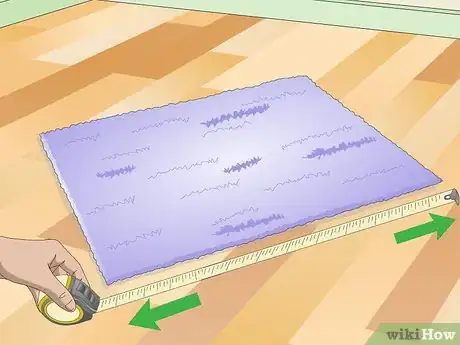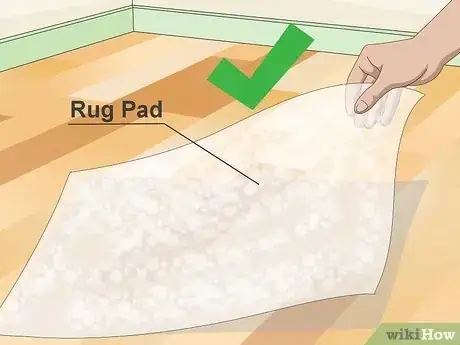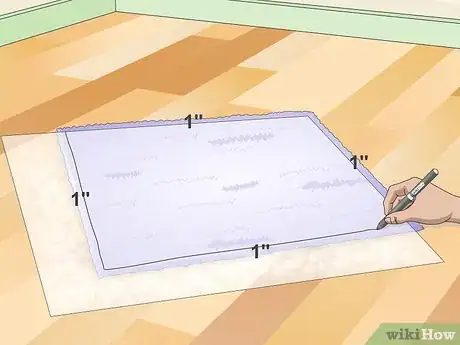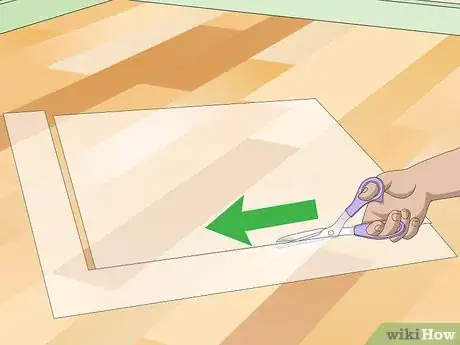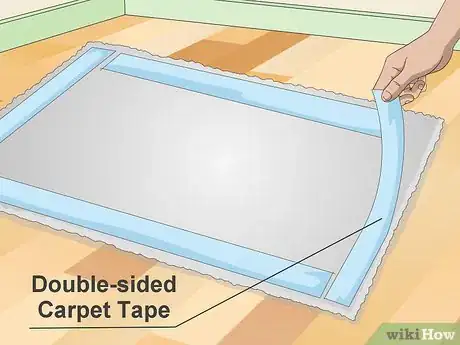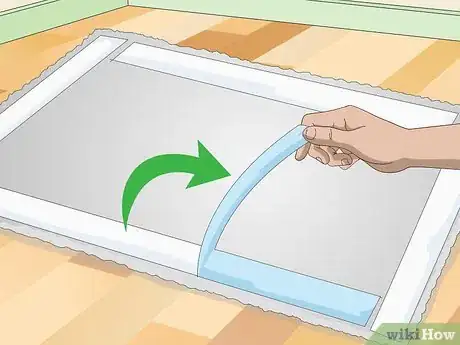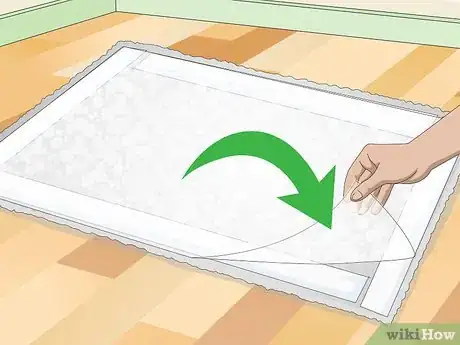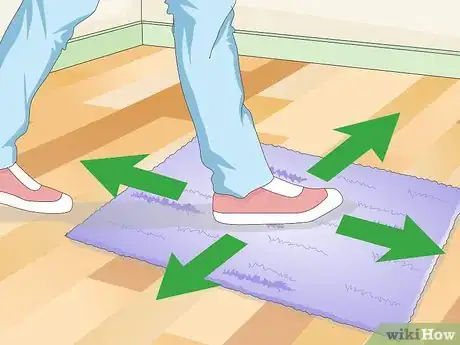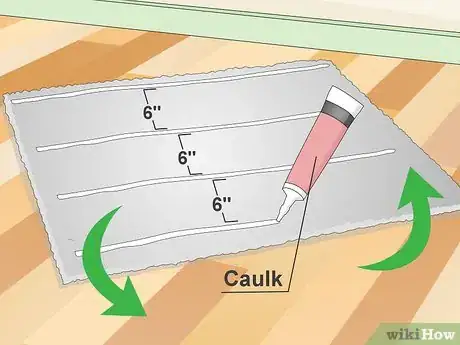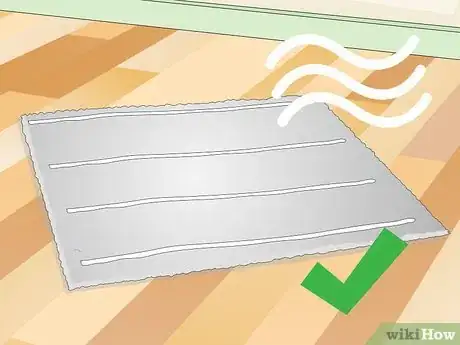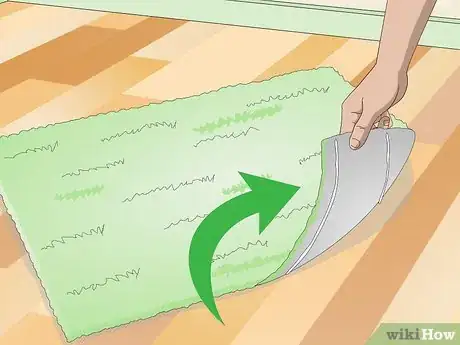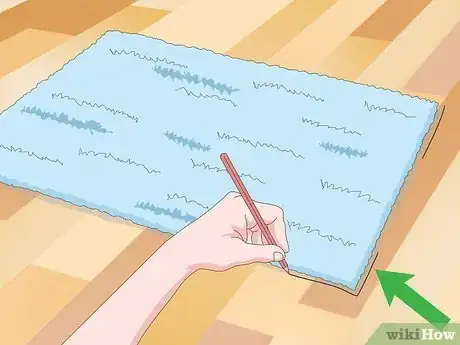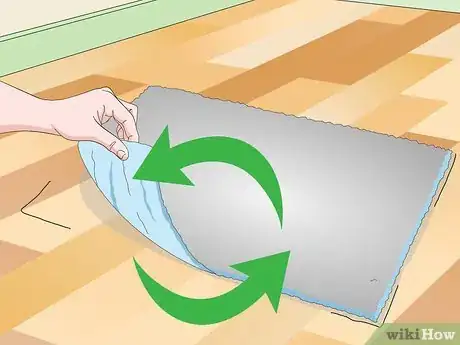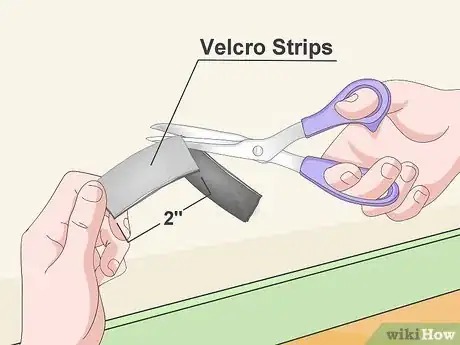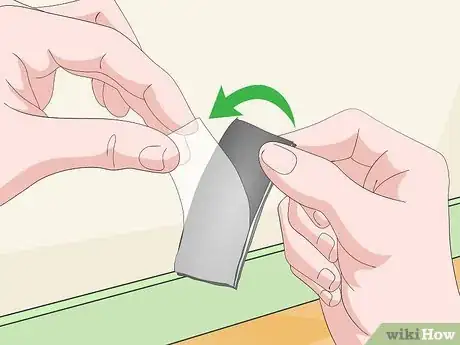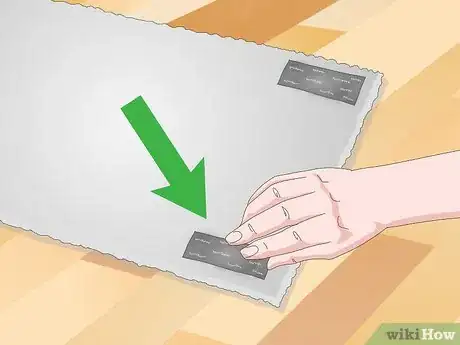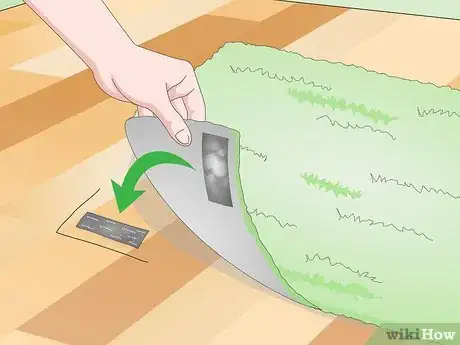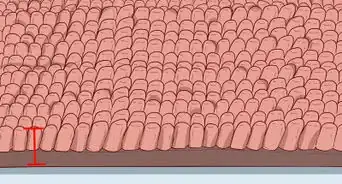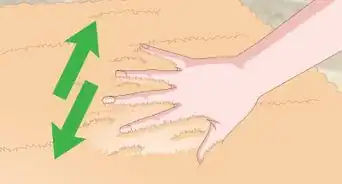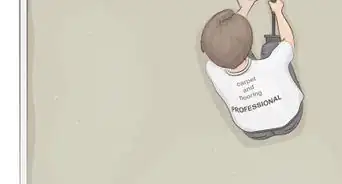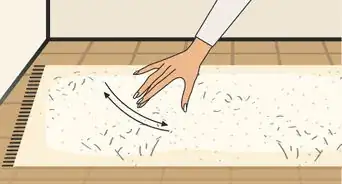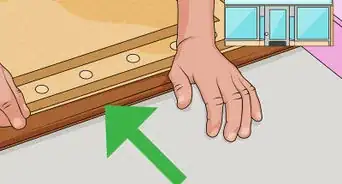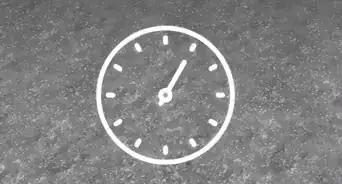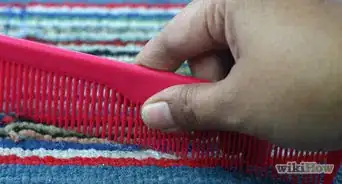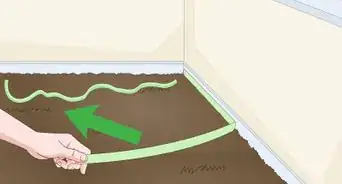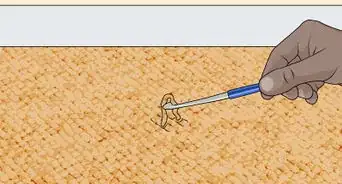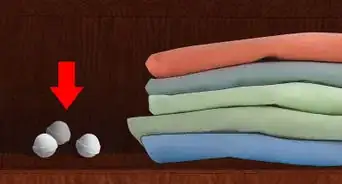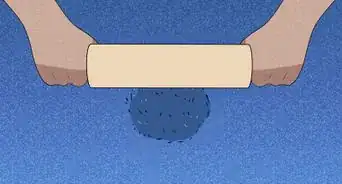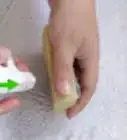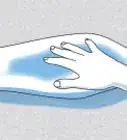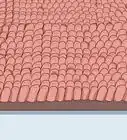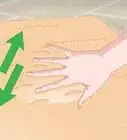This article was co-authored by Sam Adams. Sam Adams is the owner of Cherry Design + Build, a residential design and construction firm, which has been operating in the Greater Seattle Area for over 13 years. A former architect, Sam is now a full-service contractor, specializing in residential remodels and additions.
This article has been viewed 145,131 times.
While the right rug can help liven up your space, they don’t tend to stay in place on hardwood floors. Not only can this be annoying, it could eventually be a health hazard and cause a fall. Luckily, you can use a rug pad to stop your rugs from moving. You’ll need to get the right rug pad and size it appropriately before you can apply it to your rug.
Steps
Cutting and Fitting a Non-Slip Pad
-
1Measure your rug’s width and length. Before you even think about going out to purchase a rug pad, you’ll need to know your rug’s dimensions. Use a tape measure to record the length and width of the rug. If your rug has fringes, leave them out of the measurement. The rug pad won’t need to cover them.[1]
-
2Purchase the right rug pad. You can get non-slip rug pads at any home improvement store or at dedicated carpet stores. If you can’t find a rug pad that matches your rug’s size, get one that has enough excess to comfortably fit your rug.[2]
- Make sure to get a rug pad made of vinyl; materials like plastic or rubber might discolor wooden floors.[3]
Advertisement -
3Lay the pad against the rug and mark it if needed. If the rug pad is larger than your rug, you’ll need to trim it to fit. Set one of the rug pad’s corners up near the rug’s corners, leaving about an inch (2.5 cm)of clearance on either side. For each side where the rug pad hangs off, use a marker and a ruler to draw straight lines an inch (2.5 cm) away from the rug’s edge.
- Make sure the rug is upside down for this, with the bottom of the rug facing upwards.[4]
-
4Trim the rug pad to size. Use scissors to cut along the lines you’ve traced in marker. General crafting or kitchen scissors should do fine. Make sure not to catch the rug as you cut; you may want to take the rug pad away from the rug for this step if you’re worried about cutting the rug.
- You can keep the rug pad trimmings for future projects, but likely you’ll just want to throw them away.[5]
-
5Apply double-sided carpet tape to the rug. Start by cutting four strips, one for each side of the rug, sizing them so there’s about an inch or two (2.5 - 5 cm) of clearance on each side. Stick on the strips of tape.
- While sticking tape on the perimeter of the rug is sufficient, you can cut a few extra strips for the center of the rug if you want a better grip on the rug pad.[6]
-
6Remove the protective backing. Carpet tape typically has a plastic backing covering one of its sides; this prevents it from sticking to your hands as you apply it and makes sure it’ll stay sticky when it needs to be. Just peel off this plastic covering when you’re ready to stick the rug pad on.[7]
-
7Apply the rug pad. Lay the rug pad on top of the rug, making sure to center it. Apply pressure where the rug pad meets the carpet tape in order to make it stick. You may have to make a few passes to get proper grip.[8]
-
8Lay the rug on the floor and test it. Place the rug where you intend to leave it. Using your foot, apply pressure on the rug, trying to nudge it forward, backward and side to side. If you’ve applied the rug pad properly, the rug should stay in place.
- If the rug still moves, you may need to reapply the rug pad. It’s also possible you need a rug pad of a different material, depending on your floors finish. Ask a home improvement professional for guidance.[9]
Using Hot Glue or Caulk
-
1Flip the rug over and apply caulk. Follow the width of the rug when squeezing out strips of caulk. Lay strips at intervals of about 6 inches (15 cm) for the best grip.
- Acrylic-latex caulk is best for this purpose.
- Alternatively, you can use a hot glue gun to lay out grippy strips; the process will be essentially the same.[10]
-
2Let the substance dry. Leave the rug in a well ventilated room where it won’t be disturbed. If you have children or pets, you should close the door so the rug isn’t disturbed.
- Make sure to wait until the caulk (or glue) is completely dry. Placing the rug on the floor before everything’s dried will cause the rug to stick to the floor and damage it.[11]
-
3Flip the rug back and place it on the ground. Once everything’s dried, place the rug down on the floor. If you’d like to test it’s grip, just place your foot on it and try to slide it around. The dried caulk should prevent it from slipping around. If the rug doesn’t have enough grip, you can flip it over and add more strips of caulk with smaller spaces between them.[12]
Laying down Velcro Strips
-
1Mark the rug’s place on the floor with a pencil. This will help with aligning the velcro on your floor, since they won’t be easy to move once placed. Use a pencil to trace the outlines of the rug’s corners. It’s best to use a light pencil that can easily be erased.
-
2Turn the rug upside down. For the sake of simplicity, you can flip the rug right over your markings.[13]
-
3Use scissors to cut strips of velcro into 2 inch (5 cm) sections. You can buy velcro in strips at any home improvement store, usually on a roll. Make sure you have both the hook and loop sides (one is rougher to the touch than the other). Cut four strips of the soft side and four strips of the rougher side.[14]
-
4Peel the protective backing off of each strip. This plastic backing preserves the velcro strip’s adhesive properties. After peeling this off, lay the velcro strips on the ground, adhesive side facing upwards.[15]
-
5Stick a soft velcro strip in the corner of the rug. Place each strip a few inches away from the corner, adhesive side facing towards the rug. Apply pressure to the velcro strips so they’ll stick. Repeat this for each corner of the rug. Be careful in placing the velcro strips, as they’ll be hard to remove once glued on.[16]
-
6Stick the rough velcro strips on the floor. Use the placement of the velcro on the rug and the pencil markings you’ve made on the floor to help you align the velcro. Take your time applying the velcro to the floor; the adhesive is strong enough that you won’t be able to adjust the strips without completely ripping them from the floor. They’ll likely lose their adhesive property and leave glue on your floors.[17]
-
7Flip the rug back over and lay it on the ground. Align the velcro strips together, and apply pressure to each corner of the rug. The rug will now be securely held to the ground.[18]
Expert Q&A
-
QuestionDo rug pads damage hardwood floors?
 Sam AdamsSam Adams is the owner of Cherry Design + Build, a residential design and construction firm, which has been operating in the Greater Seattle Area for over 13 years. A former architect, Sam is now a full-service contractor, specializing in residential remodels and additions.
Sam AdamsSam Adams is the owner of Cherry Design + Build, a residential design and construction firm, which has been operating in the Greater Seattle Area for over 13 years. A former architect, Sam is now a full-service contractor, specializing in residential remodels and additions.
Professional Contractor The pads themselves don’t, but tiny hard things like dirt filter through the rug or get underneath it, and then they’re under there for good. Then, every time you step on the rug, it shifts a little bit, and it can actually act like a piece of sandpaper. Because of that, you need a rug pad with a little stick to it, instead of just a soft pad. And you should peel it off every once in a while and sweep underneath it.
The pads themselves don’t, but tiny hard things like dirt filter through the rug or get underneath it, and then they’re under there for good. Then, every time you step on the rug, it shifts a little bit, and it can actually act like a piece of sandpaper. Because of that, you need a rug pad with a little stick to it, instead of just a soft pad. And you should peel it off every once in a while and sweep underneath it.
Warnings
- Never stick a rug with carpet tape directly onto a wooden floor. It will leave a sticky residue that will be extremely difficult to remove.⧼thumbs_response⧽
References
- ↑ http://www.ronhazelton.com/tips/how_to_prevent_a_throw_rug_from_slipping
- ↑ http://www.ronhazelton.com/tips/how_to_prevent_a_throw_rug_from_slipping
- ↑ https://log-homes.thefuntimesguide.com/rugs_for_pine_floors/
- ↑ http://www.ronhazelton.com/tips/how_to_prevent_a_throw_rug_from_slipping
- ↑ http://www.ronhazelton.com/tips/how_to_prevent_a_throw_rug_from_slipping
- ↑ http://www.ronhazelton.com/tips/how_to_prevent_a_throw_rug_from_slipping
- ↑ http://www.ronhazelton.com/tips/how_to_prevent_a_throw_rug_from_slipping
- ↑ http://www.ronhazelton.com/tips/how_to_prevent_a_throw_rug_from_slipping
- ↑ http://www.ronhazelton.com/tips/how_to_prevent_a_throw_rug_from_slipping
- ↑ http://www.apartmenttherapy.com/make-any-rug-slip-proof-with-c-105935
- ↑ http://www.apartmenttherapy.com/make-any-rug-slip-proof-with-c-105935
- ↑ http://www.apartmenttherapy.com/make-any-rug-slip-proof-with-c-105935
- ↑ https://www.cnet.com/how-to/secure-an-area-rug-with-velcro-to-keep-it-from-sliding-around/
- ↑ https://www.cnet.com/how-to/secure-an-area-rug-with-velcro-to-keep-it-from-sliding-around/
- ↑ https://www.cnet.com/how-to/secure-an-area-rug-with-velcro-to-keep-it-from-sliding-around/
- ↑ https://www.cnet.com/how-to/secure-an-area-rug-with-velcro-to-keep-it-from-sliding-around/
- ↑ https://www.cnet.com/how-to/secure-an-area-rug-with-velcro-to-keep-it-from-sliding-around/
- ↑ https://www.cnet.com/how-to/secure-an-area-rug-with-velcro-to-keep-it-from-sliding-around/
About This Article
If your rug is always moving on your wooden floor, you can stop it with Velcro strips. Cut 4 2-inch Velcro strips and stick them to the 4 corners of your rug. If it’s a really big rug, you can add a couple more pieces in the middle. Then, stick the other halves of the Velcro strips to the floor and secure your rug to them. Another option is to use a non-slip rug pad and carpet tape. Look for a pad made of vinyl, since plastic and rubber can discolor wooden floors. It’s okay if the pad isn’t as big as your rug as long as it covers most of the surface. All you need to do is stick the pad to the bottom of your rug with double-sided carpet tape. For more tips from our Home Improvement co-author, including how to stop your rug from moving with glue, read on!
